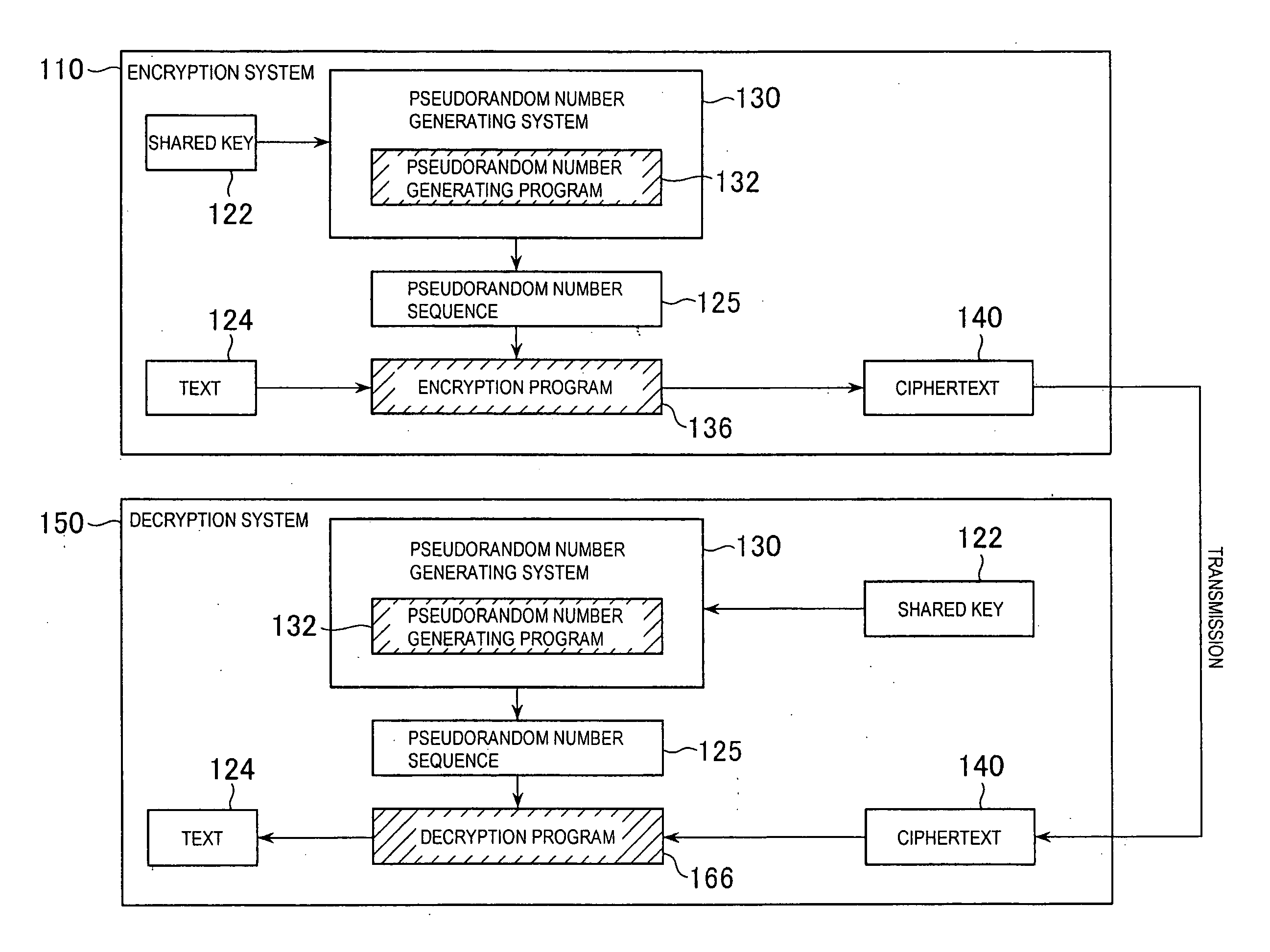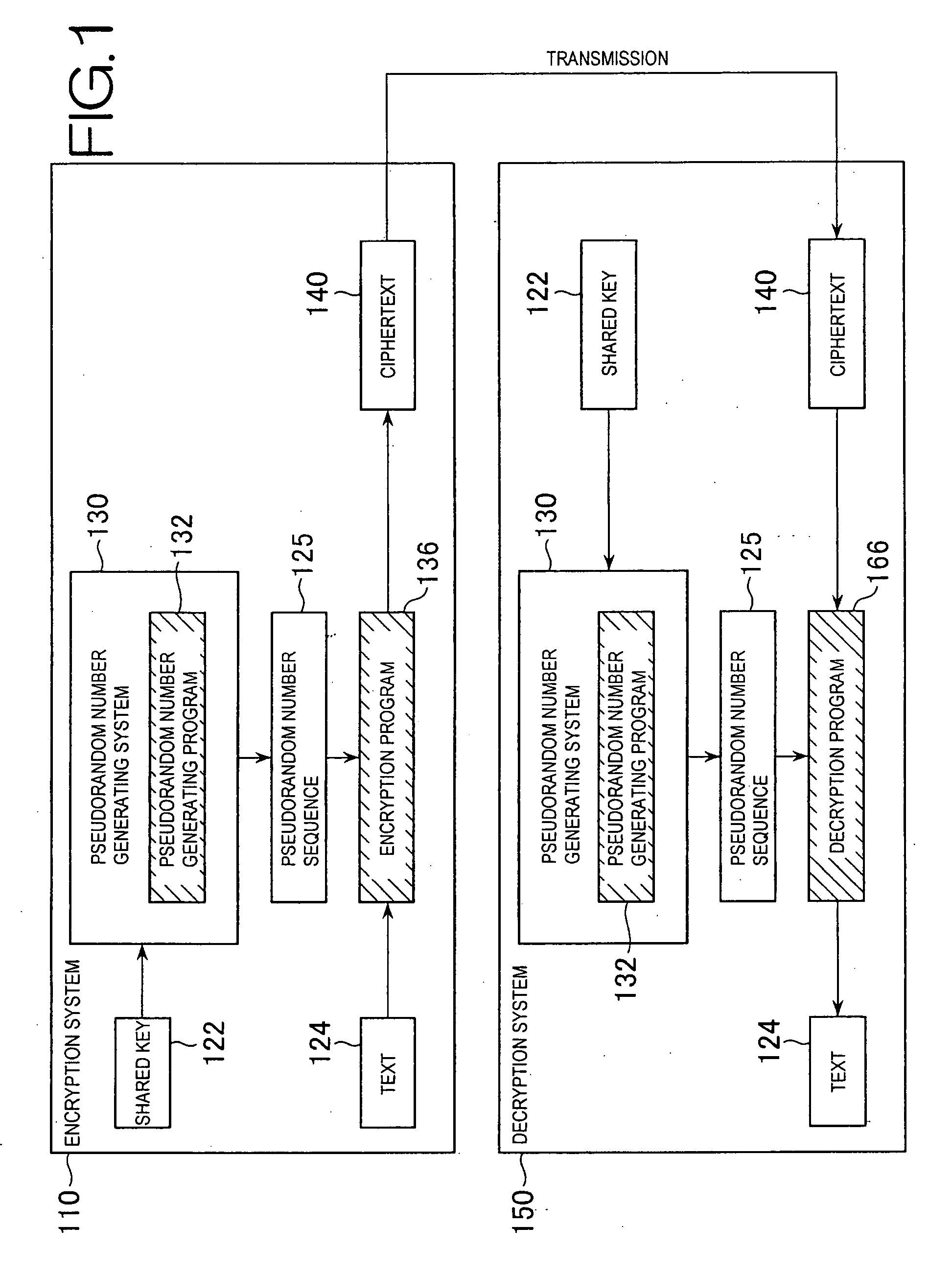Pseudorandom number generating system, encryption system, and decryption system
a technology of pseudonym and generating system, applied in the field of pseudonym generating system, encryption system, decryption system, can solve the problems of difficult to find a rule, code is broken more easily than others, and computation for generating a sufficiently secure cryptographic random number sequence is extremely slow, so as to achieve the effect of heightened cryptographic security
- Summary
- Abstract
- Description
- Claims
- Application Information
AI Technical Summary
Benefits of technology
Problems solved by technology
Method used
Image
Examples
first embodiment
[0056]The first embodiment is a pseudorandom number generating system, which is characterized in that it successively takes product of a word in a cryptographically secure pseudorandom number sequence generated from a pre-prepared sequence of numbers (shared key) and a word stored in single word memory, stores result thereof in the single word memory, and generates a secure cryptographic random number sequence from the most significant bit and subsequent bits thereof. Use of a shared key as a sequence of numbers in encrypted communication allows use of the generated cryptographic random number sequence for encryption and decryption of text by a stream cipher.
(1-1. Outline and Problems of Conventional Stream Ciphers)
[0057]Assuming BL as a collection of text blocks b, a stream cipher prepares on the encryption side a sequence of encryption functions
Ei: BL→BL′
where Ei is constituted by E1, E2, . . . ; prepares on the decryption side a sequence of decryption functions
Di: BL→BL
where Di i...
second embodiment
[0099]The second embodiment is a block cipher and shows a fundamental example of an encryption system and a decryption system, which generate a ciphertext by transforming block by block a text divided into blocks using a function, which is selected from a pseudorandom number sequence (expanded key) generated based on a shared key. The pseudorandom number sequence generated based on the shared key is used as a parameter for function selection and selected function. With the third embodiment described later, the longer a text becomes, the more the pseudorandom number sequence is consumed, however, only a fixed length is consumed in the second embodiment. Therefore, a pseudorandom number sequence with a fixed length generated based on a shared key is called ‘expanded key’.
(2-1. Outline and Problems of Conventional Block Cipher)
[0100]A conventional block cipher such as AES is configured as shown in FIG. 4(b). In other words, a block of plaintext M is taken and stored in the memory 420, ...
third embodiment
[0124]The third embodiment is a stream cipher and shows an example of an encryption system and a decryption system, which generate a ciphertext by transforming block by block a text divided into blocks using a function, which is selected based on a pseudorandom number sequence (expanded key) generated based on a shared key. Information of the shared key (the pseudorandom number sequence generated based on the shared key) is used as parameters for function selection and selected function.
[0125]The system configuration of this embodiment is as described in the above-given second embodiment using FIG. 2. In addition, processing flow thereof is as described in the second embodiment using FIG. 6. The difference from this embodiment and the above-given second embodiment is that: in the second embodiment (block cipher), when multiple functions are once selected and parameters are determined, all of the blocks are transformed using the same functions and parameters while in this embodiment ...
PUM
 Login to View More
Login to View More Abstract
Description
Claims
Application Information
 Login to View More
Login to View More - R&D
- Intellectual Property
- Life Sciences
- Materials
- Tech Scout
- Unparalleled Data Quality
- Higher Quality Content
- 60% Fewer Hallucinations
Browse by: Latest US Patents, China's latest patents, Technical Efficacy Thesaurus, Application Domain, Technology Topic, Popular Technical Reports.
© 2025 PatSnap. All rights reserved.Legal|Privacy policy|Modern Slavery Act Transparency Statement|Sitemap|About US| Contact US: help@patsnap.com



